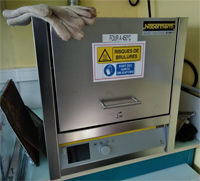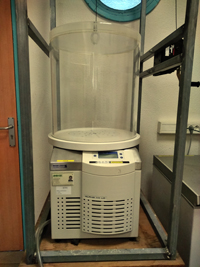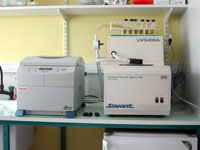
 Benthic Ecogeochemistry Laboratory
UMR 8222
Benthic Ecogeochemistry Laboratory
UMR 8222
Determination of organic matter content
 The percentage of total organic matter is obtained after calcination in an oven heated to 450 ° C. for 5 hours. The observed mass loss is attributed to organic matter. The weight of organic matter is obtained by the difference between the total weight and the weight of ash.
The percentage of total organic matter is obtained after calcination in an oven heated to 450 ° C. for 5 hours. The observed mass loss is attributed to organic matter. The weight of organic matter is obtained by the difference between the total weight and the weight of ash.Preparation of samples
 Lyophilization, or cold drying, is a process which removes the water contained in a sample in order to make it stable at room temperature and facilitate its conservation. Lyophilization uses a very simple physical principle called sublimation. Sublimation is the passage of an element from the solid state to the gaseous state directly without passing through the liquid state. In the case of water to be removed from the samples, the lyophilization steps are:
Lyophilization, or cold drying, is a process which removes the water contained in a sample in order to make it stable at room temperature and facilitate its conservation. Lyophilization uses a very simple physical principle called sublimation. Sublimation is the passage of an element from the solid state to the gaseous state directly without passing through the liquid state. In the case of water to be removed from the samples, the lyophilization steps are:- Freezing the samples at -20 ° C so that the water they contain is in the form of ice.
- Then under the effect of vacuum, sublimation of the ice directly into water vapor.
- Condensation of water vapor using a trap or condenser (temperature -50 ° C / -60 ° C).
- Once all the ice has sublimated, cold drying the samples.
Centrifugal vacuum evaporator
 The centrifugal concentrator is intended for sample preparation. The centrifugal force prevents the spraying of solutions allowing to concentrate and recover the maximum of molecules during extraction. The vacuum and the possibility of heating accelerate the evaporation of solvents.
The centrifugal concentrator is intended for sample preparation. The centrifugal force prevents the spraying of solutions allowing to concentrate and recover the maximum of molecules during extraction. The vacuum and the possibility of heating accelerate the evaporation of solvents.International collaborations
|
|
List of universities and institutes having an international partnership with LECOB |
|
|
|
Universität Rostock |
|
|
Max Planck Institute für Marine Mikrobiologie (MPI-MM), Bremen |
|
|
|
|
National Oceanography Center Southampton (NOCS) |
|
|
School of Earth and Environment, University of Leeds |
|
|
|
|
Centre d'Estudis Avançats de Blanes (CEAB) |
|
|
Universitat de Barcelona (UB) |
|
|
|
Institut de Ciencies del Mar de l'Universitat de Barcelona (ICM) |
||
|
Institut de Ciencia i Tecnologia Ambientals de l'Universitat Autònoma de Barcelona (ICTA) |
|
|
|
Instituto de Diagnóstico Ambiental y Estudios del Agua (IDAEA) |
|
|
|
|
Nederlands Instituut voor Onderzoek der Zee (NIOZ) |
|
|
|
Göteborgs universitet |
|
|
|
Universidade de São Paulo (USP) |
|
|
|
Université du Québec à Rimouski (UQAR) |
|
|
Université Laval à Québec |
|
|
|
|
Department of Marine Sciences of University of Georgia |
|
|
University of Delaware (UDEL) |
|
|
|
Woods Hole Oceanographic Institution (WHOI) |
|
|
|
|
Australian Institute of Marine Science (AIMS) |
|
|
|
Japan Agency for Marine-Earth Science and Technology (JAMSTEC) |
|
Basis of identification of some Serpulidae
- Send an email to the address This email address is being protected from spambots. You need JavaScript enabled to view it. to make your access request.
- You will then receive an email from This email address is being protected from spambots. You need JavaScript enabled to view it.
- This email gives you the procedure to create your account in order to be able to access the database.
- After your registration and first access, you can access the database by clicking on the image below:

This database was created by François CHARLES from the Laboratory of Ecogeochemistry of Benthic Environments and by Christine LE MOUNI ER from the Systematic Knowledge Base Platform developed by the Computer Science and Systematics laboratory of UPMC (Click on the logo):

Habitat-functions relationships associated to ecosytem-engineers
In fact,gorgonians, corals or other large symbiotic invertebrates interact with their physical andchemical environment by controlling the gradient of oxygen, CO2/pH, and organic and inorganicnutrients at their interface (Buhl Mortensen et al. 2009). Environmental modifications by ecosystemengineers have been largely studied at a macroscopic scale, but much less is known at the micro-scalewhere these exchange occur and the effect on associated biota. The hypothesis put forward in this axisis that hydrodynamical or biochemical micro-climates associated to particular benthic ecosystemengineers are key to facilitate or inhibit the functions that allows species assemblages to respondto environmental fluctuations (including natural and anthropogenic disturbance).
© 2025 LECOB








